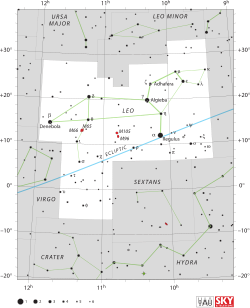Constellation of Leo
| Constellation | |

|
|
| Abbreviation | Leo |
|---|---|
| Genitive | Leonis |
| Pronunciation | /ˈliːoʊ/, genitive /liːˈoʊnɪs/ |
| Symbolism | the Lion |
| Right ascension | 11 |
| Declination | +15 |
| Quadrant | NQ2 |
| Area | 947 sq. deg. (12th) |
| Main stars | 9, 15 |
|
Bayer/Flamsteed stars |
92 |
| Stars with planets | 13 |
| Stars brighter than 3.00m | 5 |
| Stars within 10.00 pc (32.62 ly) | 5 |
| Brightest star | Regulus (α Leo) (1.35m) |
| Messier objects | 5 |
| Meteor showers | Leonids |
| Bordering constellations |
Ursa Major Leo Minor Lynx (corner) Cancer Hydra Sextans Crater Virgo Coma Berenices |
|
Visible at latitudes between +90° and −65°. Best visible at 21:00 (9 p.m.) during the month of April. |
|
Leo /ˈliːoʊ/ is one of the constellations of the zodiac, lying between Cancer the crab to the west and Virgo the maiden to the east. Its name is Latin for lion, and to the ancient Greeks represented the Nemean Lion killed by the mythical Greek hero Heracles (known to the ancient Romans as Hercules) as one of his twelve labors. Its symbol is ![]() (Unicode ♌). One of the 48 constellations described by the 2nd-century astronomer Ptolemy, Leo remains one of the 88 modern constellations today, and one of the most easily recognizable due to its many bright stars and a distinctive shape that is reminiscent of the crouching lion it depicts. The lion's mane and shoulders also form an asterism known as "The Sickle," which to modern observers may resemble a backwards "question mark."
(Unicode ♌). One of the 48 constellations described by the 2nd-century astronomer Ptolemy, Leo remains one of the 88 modern constellations today, and one of the most easily recognizable due to its many bright stars and a distinctive shape that is reminiscent of the crouching lion it depicts. The lion's mane and shoulders also form an asterism known as "The Sickle," which to modern observers may resemble a backwards "question mark."
Leo contains many bright stars, many of which were individually identified by the ancients. There are four stars of first or second magnitude, which render this constellation especially prominent:
The other named stars in Leo are Mu Leonis, Rasalas (an abbreviation of "Al Ras al Asad al Shamaliyy", meaning "The Lion's Head Toward the South"); and Theta Leonis, Chertan or Coxa ("hip").
...
Wikipedia
